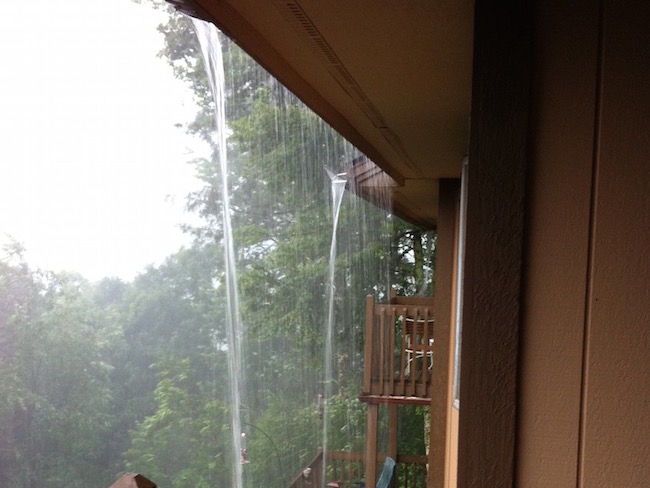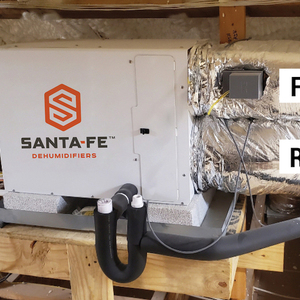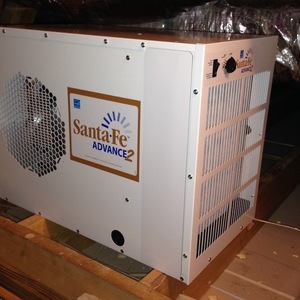
That dehumidifier you see in the photo above is in the Energy Vanguard office here in Decatur, Georgia. The compressor doesn’t come on often, but this past week I’ve heard it running quite a bit. Depending on where you’re from, you may be thinking, “Yeah, it’s always humid in the South. I don’t know how you people can stand it.” Or you may be thinking, “Wait a minute, it’s January. You shouldn’t need a dehumidifier in the Atlanta area in January.”
The latter statement is the one that aligns with our reality here. Our average high temperature in January is 53° F, and our average low temperature is 33° F. Now, those numbers don’t describe how much water vapor is in the air, but they do tell us about the limits.
Our ventilating dehumidifier
Before we get into the details of why our dehumidifier has been running, though, let me explain the setup. We changed out the furnace and air conditioner in our office in 2018 with Mitsubishi mini-split heat pumps and an Ultra-Aire ventilating dehumidifier. A local contractor we’ve worked with on consulting projects, PV Heating & Air, did the installation for us.
You can’t really tell from the photo above, but the ventilating dehumidifier actually has three ducts. The two ducts you see are the return air at the top, which brings air from the office into the dehumidifier, and the supply air at the bottom, which sends dehumidified air back into the office.
Weekly Newsletter
Get building science and energy efficiency advice, plus special offers, in your inbox.
The third duct is also at the top, behind the return air duct, and it brings in outdoor air to mix with the indoor return air. The combined air—from the office and from outdoors—goes through the dehumidifier and gets sent back into the office through the supply duct. Since it’s a ventilating dehumidifier, it can operate as a supply-only ventilation system with no dehumidification or as a supply-only ventilation system with dehumidification.
Why we’ve needed dehumidification
We know that cold air is dry air, not in terms of relative humidity—which could be 100%—but in the actual content of water vapor in the air. I like to use dew point as a proxy for that (although it’s imperfect for reasons we can explore over drinks sometime), but there are others, too, like humidity ratio and absolute humidity.
So on a day with a high temperature of 53° F, the dew point won’t be higher than 53° F. We can bring outdoor air into our office, heat it up to 70° F and not have to worry about humidity. According to the psychrometric chart, the relative humidity will be about 55%.
But this January in Decatur has been more like January in Florida. We’ve had six days in the past week with a high temperature of 65° F or higher, including two days in the 70s. And those days weren’t accompanied by sunny, dry weather. It’s been raining…a lot. We’ve had almost 4 inches of rain from 10-16 January.

When the outdoor temperature is 70° F with a relative humidity of 98%—and we’ve had those conditions— he ventilation air coming in would make our office too humid. So the compressor on our ventilating dehumidifier comes on and removes the moisture so our office stays comfortable.
The Goldilocks condition for dehumidification
Here’s what it all boils down to:
Cold weather
When it’s cold outdoors, you don’t need a dehumidifier because you can control the indoor humidity with ventilation. Cold air is dry air, you know.
Hot weather
When it’s hot and humid outdoors, you may not need a dehumidifier because the air conditioner will be running and it should do all or most of the dehumidification you need. But that’s changing as homes get more airtight and better insulated. When we build a house with a really good building enclosure, we reduce the amount of time the air conditioner needs to run and that makes controlling humidity with just the AC a bit harder. This is especially true for smaller homes, like apartments and condos.
Mild humid weather
When the temperatures are in the 60s and 70s Fahrenheit and the outdoor humidity is high, keeping the indoor conditions comfortable will probably require a dehumidifier. It’s too cool for the air conditioner to run but too warm for the outdoor air to be able to dry out the indoor air.
We have plenty of these dehumidifier Goldilocks days in the Atlanta area. They just usually don’t happen in January. I wonder what could be causing this. Hmmm….
–Allison Bailes of Decatur, Georgia, is a speaker, writer, building science consultant, and the author of the Energy Vanguard Blog. You can follow him on Twitter at @EnergyVanguard. Photos courtesy of the author.















16 Comments
Did you run an independent duct system for this or is it tied into the minisplit ducting?
Did you consider an ERV feeding the freshair port. My guess is that with the low HDD you have that that addition is not cost effective.
In the northeast, I plan on having an ERV and running a standalone dehumidifier by one of the returns if the AC is not up to the task.
A heat pump with some sort of two stage coil that could fully act as a dehumidifier would be really interesting. Does this exist it any form? It would take some interesting valving, but seems theoretically doable. I think it would be similar to Diakin's VRV heat recovery, but packaged into a single air handler.
So turns out the Daikin Quaternity units do the split evaporator approach for true dehumidification: http://www.daikinac.com/content/residential/single-zone/quaternity/control-humidity/#control-humidity
Is this done in any of the ducted systems?
>"Is this done in any of the ducted systems?"
SFAIK, not.
The split coil that enables latent cooling without sensible cooling is a patented proprietary invention owned by Daikin- I wish they made it available in their ducted heat pumps.
Great article Alison.
I would add that, the more airtight a house gets and the less infiltration there is to deal with, the more indoor humidity is based on occupant activity and the less it’s based on outdoor conditions.
For a given heat load, I would think a more airtight house would be much easier to control humidity levels in during hot humid weather than a leaky house.
I have a leaky townhouse, and running a 60 pint dehumidifier along with my AC made very little difference to the indoor humidity levels (estimate 2-3%), despite the bucket of water the dehumidifier was pulling from the air every day.
I'm currently living in a 2-year-old townhouse that's pretty tight. I have to keep mechanical ventilation going to keep our indoor CO2 levels reasonable. That's not a problem in the winter, but our indoor humidity levels skyrocket (over 70%) during our humid summers here in Virginia - despite using air conditioning. So, we also run a 70-pint dehumidifier in the summer in the main room with our fresh air intake. This fortunately helps to keep our indoor humidity near 50%. We have to empty the bucket 2-3 times a day, though.
I am planning to build in the Appalachian mts of West Virginia (zone 5). With mild but humid summers, dew point temps can be very close to outdoor temps. I need latent cooling. Does anyone have knowledge, experience or opinion of the Minotair Pentacair-V12? This unit seems like it could be the answer and it also takes care of ventilation needs. Any discussion would be appreciated; thank you! I plan on a good air barrier and better-than-code thermal barrier.
Fred,
Make sure you isolate (waterproof) the foundation from the surrounding soil. Vapor transmission through concrete is a major source of endless humidity and the 2 previous posters may be seeing this in their townhomes if built on a slab.
Good point, Doug. I run my dehumidifier in the basement so it might make sense that it pulls decent amounts of moisture without much effect on the rest of the house if that moisture is coming through the slab and foundation walls.
I’m sure infiltration is still an issue. I did a mock “blower door” setup and identified some serious air leaks in the enclosure.
Thank you Doug. I learned this lesson the hard way...we had a cabin in the woods with a dirt floor crawl space, and water would literally drip off interior surfaces in the summer. 6 mil poly (not exactly waterproof) on the dirt floor helped, but not enough. Around here, rainy, humid air needs moisture removal for comfort.
I recently moved from Fairbanks (where HRVs are standard, and humidity is too low) to Michigan (where mechanical ventilation is practically unheard of, and humidity is too high). So, I'm looking into residential-scale ventilating dehumidifiers. I'm a strong believer in mech ventilation for IAQ (especially in these older midwestern homes), and we rarely use AC (I hate the feel of it), so we're often in part-load conditions. Ventilating dehumidifiers seems like a perfect fit for my family in this new-to-me climate (Zone 5), right? Do you have any suggestions for residential models?
The biggest challenge, I think, will be finidng a contractor that's familiar with these. From a little bit of poking around, it sounds like nobody has heard of this in my area.
I'd appreciate any suggestions you have. Thanks
>"Ventilating dehumidifiers seems like a perfect fit for my family in this new-to-me climate (Zone 5), right? '
Combining ventilation and humidity control features into a single appliance usually doesn't optimize either. High humidity in MI is only seasonal, but ventilation is necessary every day of the year, and even the peak dew points aren't anywhere near what they are in the gulf coast states where Allison lives & works.
Any ducted ventilation system with a recirculation function would allow a standalone dehumidifier to be placed anywhere in the house to control humidity, without it being part of the same appliance.
It's possible to parse your question in such a way that you may be asking whether you're in zone 5. Only the southern half of the mitt is zone 5, the rest is zone 6, and parts of the UP are zone 7.
My back of envelope calculation tells me that I need maybe 50 pints water removed on a 70 degree day. Minotair claims their unit can remove 118. Is it inefficient? If so could you please explain why? Thanks in advance. I don't mind a separate duct system.
Keep in mind dehumidifiers are rated at 80F and 60% RH, conditions that shouldn't be encountered in a house (in my opinion, anyway). As the temperature drops and/or the RH drops, the capacity of a dehumidifier lowers relative to its spec. Based on the specs I have for a Honeywell DR90 dehumidifier, going from 80-70F and 60-50% RH drops the performance from 97 to 53 PPD, or 55% of its rated capacity. I would imagine the performance of most dehumidifiers would follow that same trend.
It's efficiency also drops from 6.3 to 4.1 pints/kWh, not that it really matters, just an interesting spec.
Dehumidifiers also add heat to a house. The net effect of drier air at a slightly elevated temperature might feel cooler, but you're starting to talk about a pretty hot house, I'd think. Do you dislike the feel of an air conditioned home, or do you dislike the feel of cold air shooting out of a vent? There is a difference, and properly designed vents and ductwork can all but eliminate the latter.
Thank you Lance. The conditions I need to address are identical to what Allison describes: 70 degree (+/-5) at 90+% RH. I don't want cooling and I don't want to add much heat.
These comments seem to be buried in the GBA site. I'm a new poster and I think I should have posted in the Question section instead. I will repost my original question re Minotair to try to get additional responses. I appreciate your help.
Reply to post #14
Re-reading the last paragraph of my post, I realize it sounds a little bit harsh. That was not the intention, and the added heat comment sounds like a big deal where it might not actually be.
If you are thinking you may need 50 pints/day of moisture removal, here's some basic heat load information. If we assume 48 pints (for easy math), that's 2 pints/hr. Using the reduced efficiency from the humidifier I mentioned above (which is still pretty high for a dehumidifier at 4.1 pints/kWh), that's about 0.5kWh/hr x 3412 Btu/kWh = 1700 Btu/hr.
That's not a lot of heat, about 1/7 ton, but on a hot summer day it's something to consider. A smaller less efficient dehumidifier would add more, perhaps up to twice as much.
The Minotair might be the perfect solution for your needs, come to think of it. It actually provides cooling along with dehumidification because it rejects the heat of the refrigeration cycle to the outgoing exhaust air. It's capacity is only about one ton (11,500 Btu) so it won't be capable of cooling a large house, but it certainly would help as well as dehumidifying the incoming air. It also has quite high maximum airflow at 250 CFM (for a ventilation system), so the cooling capacity would be reduced if using it at lower airflow rates.
If you don't mind me asking, how did you come to the 50 pint/day dehumidification requirement? I would think a house built to very airtight standards wouldn't require anywhere near that much dehumidification unless the occupants were very actively generating moisture and/or the home's ventilation system was very poorly designed.
If you'd rather discuss in a new conversation dedicated to the Minotair, please post a link and I'll continue there.
Thanks so much Lance! I just now posted the question in the "Q&A" section. I will also add a post where I describe my estimates/calculations.
Log in or create an account to post a comment.
Sign up Log in